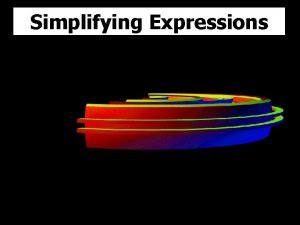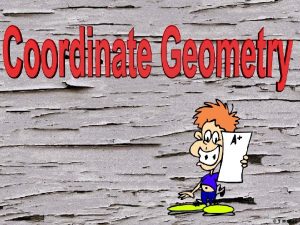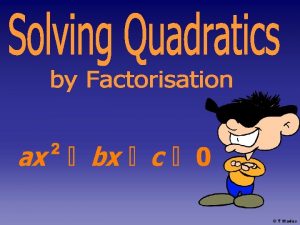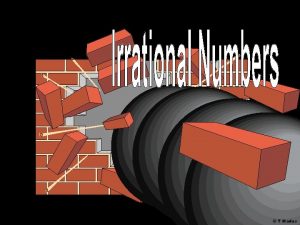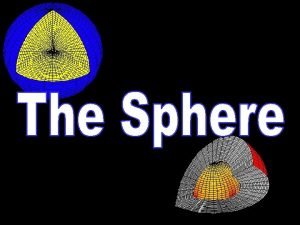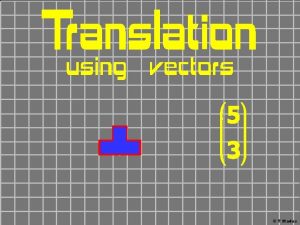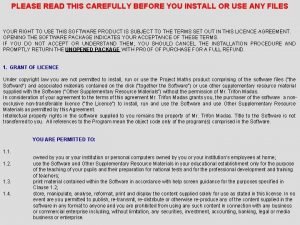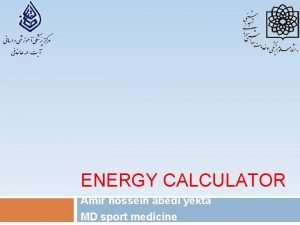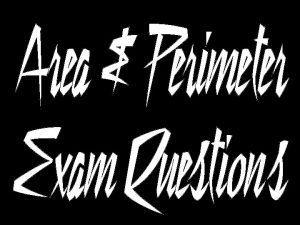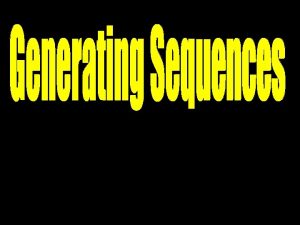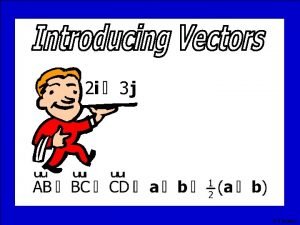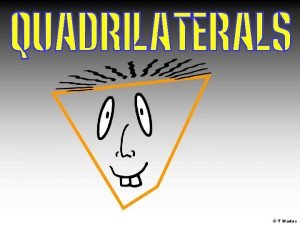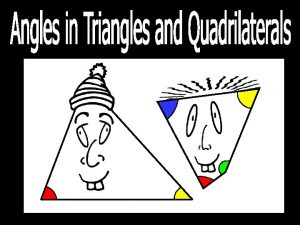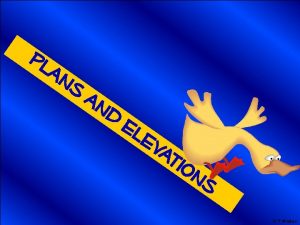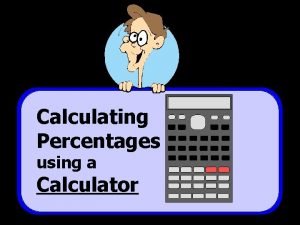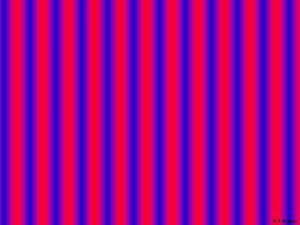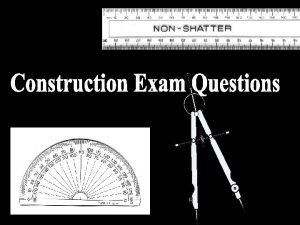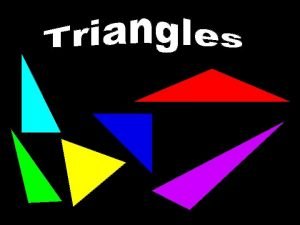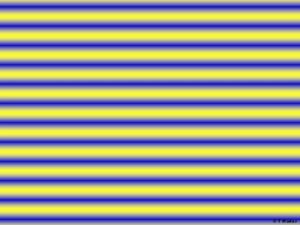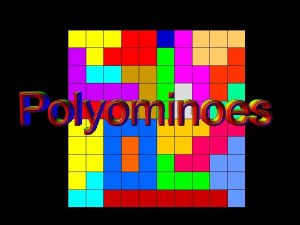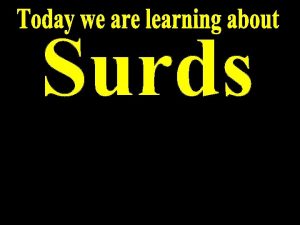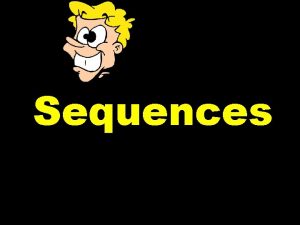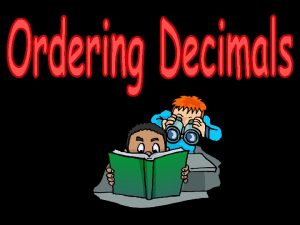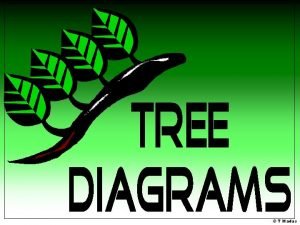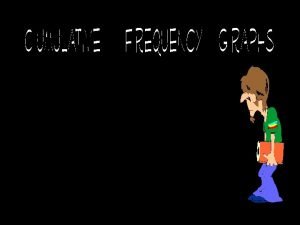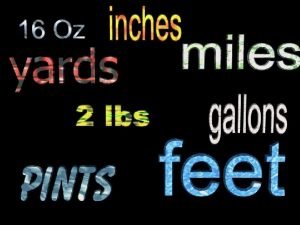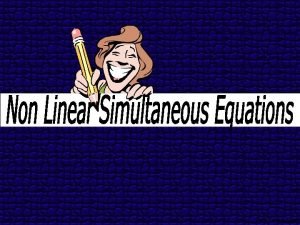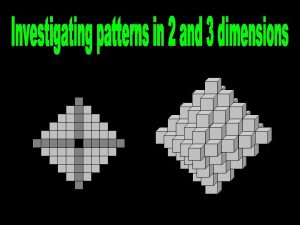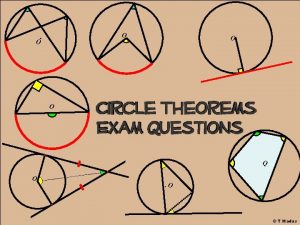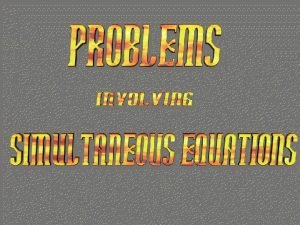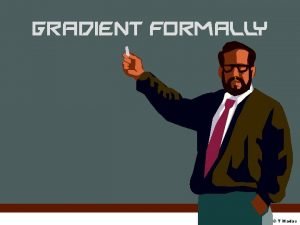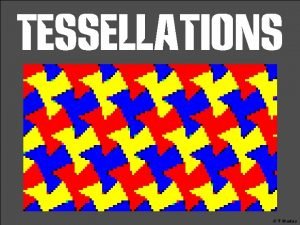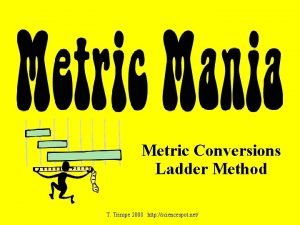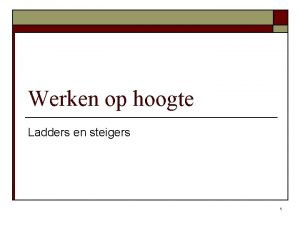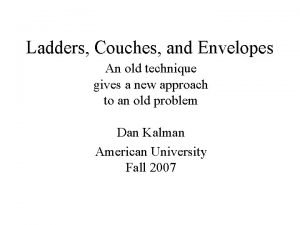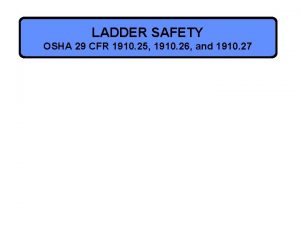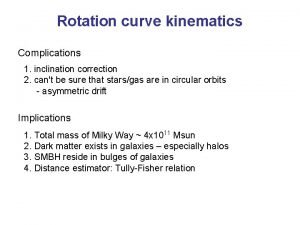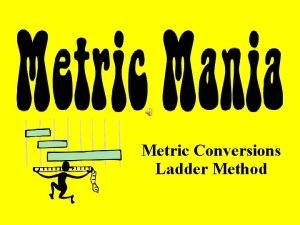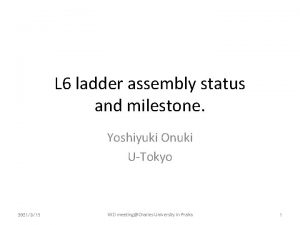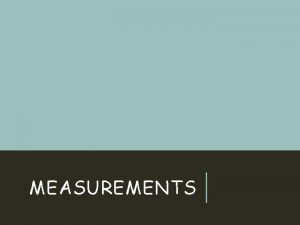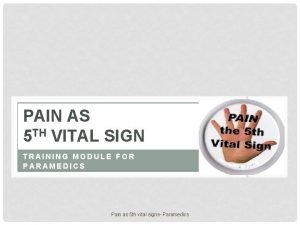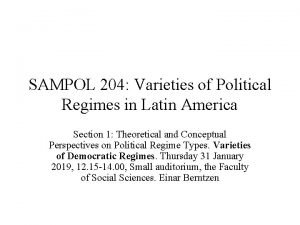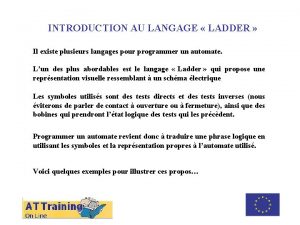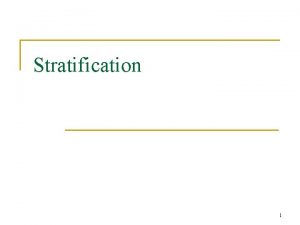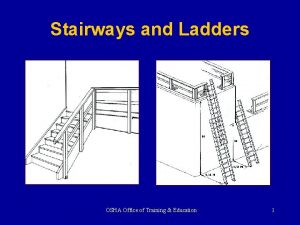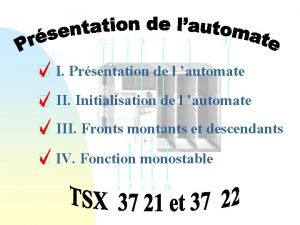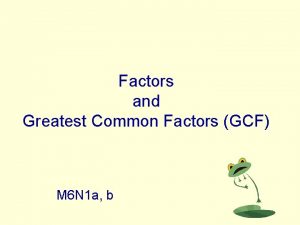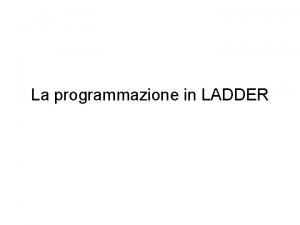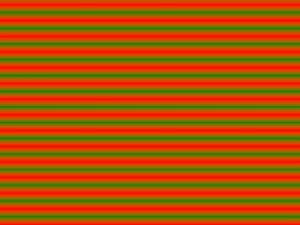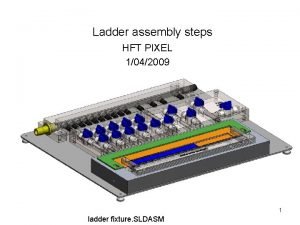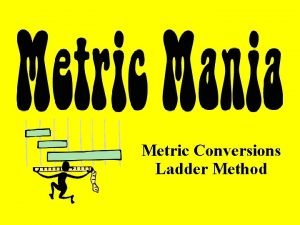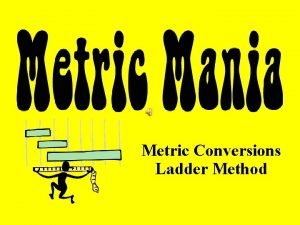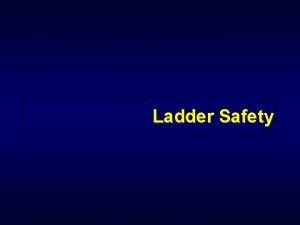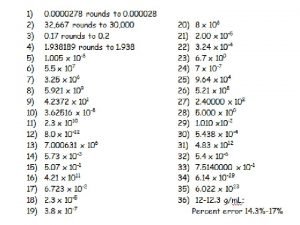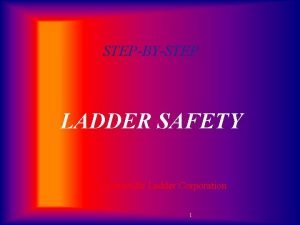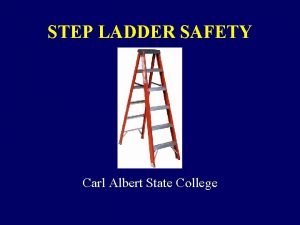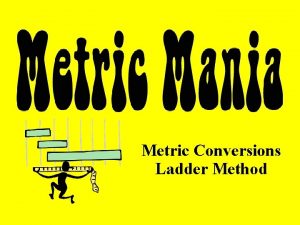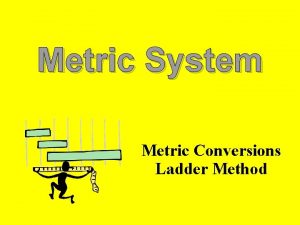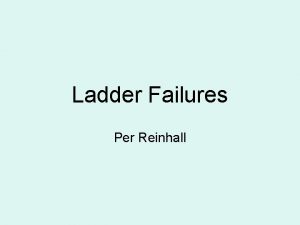T Madas T Madas A ladder is 5






















![[ 3 x ]2 + [ 4 x ]2 = 242 25 x 2 [ 3 x ]2 + [ 4 x ]2 = 242 25 x 2](https://slidetodoc.com/presentation_image_h/07fcf329374c7534090d1866784c7f81/image-23.jpg)

















































- Slides: 72

© T Madas

© T Madas

A ladder is 5 m long and is placed against a wall which is taller than the ladder. The foot of the ladder is placed 1. 4 m away from the wall. Calculate how high up the wall will the ladder reach. 1. 4 2 + x 2 = 5 2 1. 96 + x 2 = 25 x 5 m x 2 = 25 – 1. 96 x 2 = 23. 04 x = 23. 04 c c c By Pythagoras Theorem: x = 4. 8 m 1. 4 m © T Madas

© T Madas

A flagpole OB is held into an upright position by two guy ropes AB and CB as shown in the diagram. AB = 4. 5 m, AO = 2. 7 m and OC = 1. 5 m. Calculate the length of the rope CB. 2. 72 + x 2 = 4. 52 7. 29 + x 2 = 20. 25 – 7. 29 x 2 = 12. 96 4. 3. 6 5 x x = 12. 96 A 2. 7 1. 5 c c c By Pythagoras Theorem: B x = 3. 6 m C O © T Madas

A flagpole OB is held into an upright position by two guy ropes AB and CB as shown in the diagram. AB = 4. 5 m, AO = 2. 7 m and OC = 1. 5 m. Calculate the length of the rope CB. 1. 52 + 3. 62 = y 2 3. 6 4. A 2. 7 y 2 = 15. 21 y y = 15. 21 3. 9 5 2. 25 + 12. 96 = y 2 1. 5 c c By Pythagoras Theorem: B y = 3. 9 m C O © T Madas

© T Madas

Calculate the area of the following right angled triangle: 12 2 + x 2 = 37 2 144 + x 2 = 1369 cm 35 cm 37 x 2 = 1369 – 144 x x 2 = 1225 x = 1225 c c c By Pythagoras Theorem: x = 35 cm 12 cm A= b x 2 h 12 x 35 = = 210 cm 2 2 © T Madas

© T Madas

10 xcm 8 cm 62 + 8 2 = x 2 36 + 64 = x 2 100 = x 10 = x c c c 15 cm 10 cm 6 cm The following kite has the following measurements. Calculate the perimeter of this kite. x = 10 © T Madas

cm 82 + 152 = y 2 64 + 225 = y 2 289 = y 2 cm 289 = y cm y 17 = y c c c 10 17 17 15 cm 10 cm 6 cm The following kite has the following measurements. Calculate the perimeter of this kite. x = 17 The perimeter of this kite is 54 cm © T Madas

© T Madas

Calculate the area of the trapezium shown below: cm cm 17 17 8 cm h 8 2 + h 2 = 17 2 64 + h 2 = 289 – 64 36 cm h 2 = 225 c c By Pythagoras Theorem: 20 cm h = 15 cm © T Madas

Calculate the area of the trapezium shown below: 15 cm cm cm 17 17 8 cm 8 2 + h 2 = 17 2 64 + h 2 = 289 – 64 h 2 = 225 36 cm c c By Pythagoras Theorem: 20 cm h = 15 cm A= 8 x 15 x 2 120 cm 2 = 2 A = 20 x 15 = 300 cm 2 The trapezium has an area of 420 cm 2 © T Madas

Exam Question © T Madas

An A 4 size sheet of card is a rectangle 297 mm long by 209 mm wide. (a) Calculate the length of its diameter (b) Find the acute angle formed by the diagonal and the longer of the two sides of the rectangle 209 mm B A C 36 3 d m m 297 mm D © T Madas

An A 4 size sheet of card is a rectangle 297 mm long by 209 mm wide. (a) Calculate the length of its diameter (b) Find the acute angle formed by the diagonal and the longer of the two sides of the rectangle 209 mm B A C 36 3 Which trig ratio can we use? m m θ 297 mm We can use trig to find θ D Why should we avoid using a ratio which involves the length of 363 mm? © T Madas

An A 4 size sheet of card is a rectangle 297 mm long by 209 mm wide. (a) Calculate the length of its diameter (b) Find the acute angle formed by the diagonal and the longer of the two sides of the rectangle 209 mm B A C 36 3 tanθ = m m 35° θ 297 mm D opp adj 209 tanθ = 297 209 -1 θ = tan 297 [ ] θ ≈ 35° © T Madas

Exam Question © T Madas

The perpendicular sides of a right angled triangle are in the ratio of 5 : 12. Its hypotenuse is 65 cm. Find the lengths of its perpendicular sides B (5 x )2 + (12 x)2 = 652 4225 169 x 2 = 25 x 2 = cm A 169 x 2 = 4225 65 12 x 25 x 2 + 144 x 2 = 4225 5 x C AC : AB = 5 : 12 x=5 AC = 25 cm AB = 60 cm © T Madas

© T Madas

The ratio of length : width of a rectangular TV screen is 4 : 3. Calculate, in inches, the length and width of this screen, if its diagonal measurement is 24 inches. [ 3 x ]2 + [ 4 x ]2 = 242 25 x 2 = 576 c c c 4 x By Pythagoras Theorem x 2 = 576 c 3 x 24’’ 9 x 2 + 16 x 2 = 576 Why not ± the square root? 25 x = 576 25 © T Madas
![3 x 2 4 x 2 242 25 x 2 [ 3 x ]2 + [ 4 x ]2 = 242 25 x 2](https://slidetodoc.com/presentation_image_h/07fcf329374c7534090d1866784c7f81/image-23.jpg)
[ 3 x ]2 + [ 4 x ]2 = 242 25 x 2 = 576 c c c 4 x 19. 2’’ By Pythagoras Theorem x 2 = 576 c 3 x 24’’ 9 x 2 + 16 x 2 = 576 25 x = 24 = 4. 8 5 c 14. 4’’ The ratio of length : width of a rectangular TV screen is 4 : 3. Calculate, in inches, the length and width of this screen, if its diagonal measurement is 24 inches. © T Madas

© T Madas

The figure below shows a right angled trapezium ABCD. All lengths are in cm [not to scale] Calculate the length of BC. x 10. 89 + 31. 36 = x 2 3. 3 lengths in cm C x 2 = 42. 25 x = 42. 25 c c 5. 6 6 3. 32 + 5. 62 = x 2 5 D By Pythagoras Theorem: B 2. 7 6. 5. 6 A x = 6. 5 cm © T Madas

© T Madas

The figure below shows the cross section of a barn. AE = AB and all lengths are in metres [not to scale] Calculate the length of AB. E By Pythagoras Theorem: x 3 5. B 11 8. 2 4. 5 D 9 2. 82 + 4. 52 = x 2 C 7. 84 + 20. 25 = x 2 = 28. 09 x = 28. 09 c c 2. 8 A x = 5. 3 m lengths in metres © T Madas

© T Madas

Calculate the area of a square whose diagonal is 8 cm B A 8 x x 2 + x 2 = 82 2 x 2 = 64 x 2 = 32 cm D cc x C Area = x 2 = 32 cm 2 Do we need to find the square root of 32? What are we trying to find? Is there another way to solve this problem? © T Madas

Calculate the area of a square whose diagonal is 8 cm A 42 + 42 = x 2 16 + 16 = x 2 cm cm 8 x cm cc x 4 C 4 B x 2 = 32 D Area = x 2 = 32 cm 2 © T Madas

© T Madas

A rectangle measuring 5 cm by 12 cm is drawn inside a circle, whose centre is at point O. Calculate the circumference of the circle, correct to 3 s. f. 52 + 122 = d 2 25 + 144 = d 2 5 cm d d 2 = 169 O d = 169 d = 13 cm 12 cm c C = π x 13 C = 40. 8 cm c C=πxd c c By Pythagoras Theorem: [3 s. f. ] © T Madas

The Drink and the Straw © T Madas

The Drink and the Straw Will the straw be completely covered by the drink in the glass? 18 cm 15 cm 4 cm If not what length will remain out of the drink? © T Madas

The Drink and the Straw 4 cm 152 + 82 = x 2 x 18 cm 17 cm 15 cm 225 + 64 = x 2 289 = x 2 =x 8 cm © T Madas

The Drink and the Straw Will the straw be completely covered by the drink in the glass? cm 18 17 cm 15 cm 4 cm If not what length will remain out of the drink? 8 cm © T Madas

© T Madas

The right angled trapezium ABCD below represents the cross section of a swimming pool. [not drawn to scale] 1. Calculate the area of ABCD. 2. Calculate the length AD. B 12 m C 0. 4 m A 2. 6 m D A= B +b 2 xh = 2. 6 + 0. 4 x 12 = 1. 5 x 12 = 18 m 2 2 © T Madas

The right angled trapezium ABCD below represents the cross section of a swimming pool. [not drawn to scale] 1. Calculate the area of ABCD. 2. Calculate the length AD. B 12 m 0. 4 m 12 m A d d 2 = 148. 84 d = 148. 84 c c 4. 84 + 144 = d 2 2. 6 m 2. 2 m D By Pythagoras Theorem: 2. 22 + 122 = d 2 C d = 12. 2 m © T Madas

© T Madas

2 b h 1 1 b 12 + 12 = b 2 1 + 1 = b 2 2 = b 2 = 2 b = 2 c c Part of a 5 by 5 square is shaded by a triangle as shown below. What percentage of the square is shaded? 1 1 A= b x h 2 © T Madas

2 b h 1 1 2 12 + 12 = b 2 1 + 1 = b 2 2 = b 2 = 2 b = 2 c c Part of a 5 by 5 square is shaded by a triangle as shown below. What percentage of the square is shaded? 1 1 A= b x h 2 © T Madas

Part of a 5 by 5 square is shaded by a triangle as shown below. What percentage of the square is shaded? h 2 A= b x h 2 © T Madas

Part of a 5 by 5 square is shaded by a triangle as shown below. What percentage of the square is shaded? h 2 A= b x h 2 © T Madas

Part of a 5 by 5 square is shaded by a triangle as shown below. What percentage of the square is shaded? The triangle has an area of 4. 5 square units The square has an area of 25 square units 9 2 2 4. 5 18 = = 18% 25 100 2 A= b x 2 h = 2 x 9 2 2 2 = 2 x 9 2 2 = 9 2 © T Madas

© T Madas

Two circles with radii of 3 cm and 7 cm touch each other. If the line RT is a tangent to both circles calculate its length, correct to one decimal place. Q P 4 OP = 10 OP PRT and 9. 2 10 R 7 T 3 OP = RT By using Pythagoras Theorem on VOPQ : PQ 2 + OQ 2 = OP 2 42 + OQ 2 = 10 2 – 42 OQ 2 = 84 [all lengths in cm] c c O 3 A tangent is perpendicular to a radius at the point of contact OQ ≈ 9. 2 cm © T Madas

© T Madas

13 + 5 The right angled triangle shown below has the lengths of two of its sides given in terms of surds. 1. Show that the area of this triangle is 4 square units 2. Show that the hypotenuse of the triangle is 6 units long. 13 – 5 © T Madas

The right angled triangle shown below has the lengths of two of its sides given in terms of surds. 1. Show that the area of this triangle is 4 square units 2. Show that the hypotenuse of the triangle is 6 units long. We could have used an identity on the numerator 13 + 5 A=b x 2 h = 13 + 5 x 13 – 5 2 13 – 13 x 5 + 5 x 13 – 5 = 2 = 4 square units 13 – 5 © T Madas

The right angled triangle shown below has the lengths of two of its sides given in terms of surds. 1. Show that the area of this triangle is 4 square units 2. Show that the hypotenuse of the triangle is 6 units long. We could have used an identity on the numerator (a + b) (a – b) 13 + 5 A=b x 2 h = 13 + 5 x a 2 – b 2 13 – 5 2 13 – 13 x 5 + 5 x 13 – 5 = 2 = 4 square units 13 – 5 © T Madas

The right angled triangle shown below has the lengths of two of its sides given in terms of surds. 1. Show that the area of this triangle is 4 square units 2. Show that the hypotenuse of the triangle is 6 units long. 2 2 13 + 5 d = 13 + 5 + 13 – 5 d 2 = 18 + 2 65 + 18 – 2 65 13 + 5 x 13 + 5 = 13 + 13 x 5 + 5 x 13 + 5 = 18 + 65 = 18 + 2 65 13 – 5 x 13 – 5 = 13 – 13 x 5 – 5 x 13 + 5 13 – 5 = 18 – 65 = 18 – 2 65 © T Madas

The right angled triangle shown below has the lengths of two of its sides given in terms of surds. 1. Show that the area of this triangle is 4 square units 2. Show that the hypotenuse of the triangle is 6 units long. We could have used an identity to speed up the calculations 2 2 d = 13 + 5 + 13 – 5 2 = 18 + 2 65 + 18 – 2 65 d 2 = 36 13 + 5 d = 6 units d 13 – 5 © T Madas

The right angled triangle shown below has the lengths of two of its sides given in terms of surds. 1. Show that the area of this triangle is 4 square units 2. Show that the hypotenuse of the triangle is 6 units long. We could have used an identity to speed up the calculations 2 2 d = 13 + 5 + 13 – 5 2 13 + 5 d 2 = 13 + 5 + 2 x 13 x 5 + 13 + 5 – 2 x 13 x 5 d d 2 = 36 d = 6 units (a ± b )2 a 2 ± 2 a b + b 2 13 – 5 © T Madas

© T Madas

13 + 5 The right angled triangle shown below has the lengths of two of its sides given in terms of surds. 1. Show that the area of this triangle is 4 square units 2. Show that the hypotenuse of the triangle is 6 units long. 13 – 5 © T Madas

The right angled triangle shown below has the lengths of two of its sides given in terms of surds. 1. Show that the area of this triangle is 4 square units 2. Show that the hypotenuse of the triangle is 6 units long. We could use an identity on the numerator (a + b) (a – b) 13 + 5 A=b x 2 h = 13 + 5 x a 2 – b 2 13 – 5 = 2 = 4 square units 13 – 5 © T Madas

The right angled triangle shown below has the lengths of two of its sides given in terms of surds. 1. Show that the area of this triangle is 4 square units 2. Show that the hypotenuse of the triangle is 6 units long. 2 2 d = 13 + 5 + 13 – 5 2 13 + 5 d 2= 13 + 5 + 2 x 13 x 5 + 13 + 5 – 2 x 13 x 5 d d 2= 36 d = 6 units Using the identity: 13 – 5 (a ± b )2 a 2 ± 2 a b + b 2 © T Madas

© T Madas

A right angled triangle can have sides with lengths which are rational or irrational numbers of units of length. Give an example of a right angled triangle which has: 1. 2. 3. 4. 5. all 3 sides rational numbers. irrational hypotenuse and the other two sides rational numbers. rational hypotenuse and the other two sides irrational numbers. all 3 sides irrational numbers hypotenuse and one of the other 2 sides rational numbers and the 3 rd side an irrational number. 5 4 1 or any Pythagorean triple or its multiples 3, 4, 5 5, 12, 13 8, 15, 17 7, 24, 25 20, 21, 29 9, 40, 41 etc 3 © T Madas

A right angled triangle can have sides with lengths which are rational or irrational numbers of units of length. Give an example of a right angled triangle which has: 1. 2. 3. 4. 5. all 3 sides rational numbers. irrational hypotenuse and the other two sides rational numbers. rational hypotenuse and the other two sides irrational numbers. all 3 sides irrational numbers hypotenuse and one of the other 2 sides rational numbers and the 3 rd side an irrational number. 52 6 2 Any two rational values for the perpendicular sides will do… … provided the two rational values are not part of a Pythagorean triple. 62 + 42 = 52 2 4 © T Madas

A right angled triangle can have sides with lengths which are rational or irrational numbers of units of length. Give an example of a right angled triangle which has: 1. 2. 3. 4. 5. all 3 sides rational numbers. irrational hypotenuse and the other two sides rational numbers. rational hypotenuse and the other two sides irrational numbers. all 3 sides irrational numbers hypotenuse and one of the other 2 sides rational numbers and the 3 rd side an irrational number. 36 21 3 15 the hypotenuse being rational implies… … being a number with an exact square root … … the other two sides must be non exact square roots which squared and added give 36. 2 2 15 + 21 = 36 2 © T Madas

A right angled triangle can have sides with lengths which are rational or irrational numbers of units of length. Give an example of a right angled triangle which has: 1. 2. 3. 4. 5. all 3 sides rational numbers. irrational hypotenuse and the other two sides rational numbers. rational hypotenuse and the other two sides irrational numbers. all 3 sides irrational numbers hypotenuse and one of the other 2 sides rational numbers and the 3 rd side an irrational number. 28 17 4 Pick two non exact square roots for the two perpendicular sides… … as long as squared and added do not produce an exact square root. 2 2 17 + 11 = 28 2 11 © T Madas

A right angled triangle can have sides with lengths which are rational or irrational numbers of units of length. Give an example of a right angled triangle which has: 1. 2. 3. 4. 5. all 3 sides rational numbers. irrational hypotenuse and the other two sides rational numbers. rational hypotenuse and the other two sides irrational numbers. all 3 sides irrational numbers hypotenuse and one of the other 2 sides rational numbers and the 3 rd side an irrational number. 4 3 5 Pick two whole numbers for the hypotenuse and one of the two perpendicular sides… … this will produce a non exact square root for the third side unless the 3 numbers form a Pythagorean triple… 2 2 7 +3 =4 2 7 © T Madas

© T Madas

The figure below shows two circles sharing the same centre O and having radii R and r with R > r. AB is a tangent to the smaller circle and has a length of 8 cm. 1. Write down an expression for the area of the shaded region. 2. Calculate the area of the shaded region, to 3 s. f. B O r R 4 A πR 2 πr 2 Shaded Area = πR 2 – π r 2 =π R 2 – r 2 = π x 16 Area of big circle = Area of small circle = ≈ 50. 3 cm 2 r 2 + 42 = R 2 ⇔ 16 = R 2 – r 2 © T Madas

© T Madas

Point P lies inside a rectangle ABCD, so that AP = 4 cm, BP = 3 cm and CP = 5 cm. Calculate the distance DP. C B 3 y 4 c m cm v A x By Pythagoras Theorem: m 5 c x 2+ v 2 = 9 u 2 + v 2 = 25 x 2 + y 2 = 16 u 2+ y 2= d 2 P d u D Plan: to find d, we must find d 2 to find d 2, we must find u 2 and y 2 we must do so from the first three equations © T Madas

Point P lies inside a rectangle ABCD, so that AP = 4 cm, BP = 3 cm and CP = 5 cm. Calculate the distance DP. C B 3 y 4 c A x x 2+ v 2 = 9 u 2 + v 2 = 25 x 2 + y 2 = 16 u 2+ y 2= d 2 P m cm v By Pythagoras Theorem: m 5 c d u D 1 x 2+ v 2 = 9 2 u 2 + v 2 = 25 3 x 2 + y 2 = 16 4 u 2+ y 2= d 2 © T Madas

Point P lies inside a rectangle ABCD, so that AP = 4 cm, BP = 3 cm and CP = 5 cm. Calculate the distance DP. C B m 5 c 3 P y A 4 c m cm v 3 x 2 + y 2 = 16 1 x 2+ v 2 = 9 x 1 x 2+ v 2 = 9 2 u 2 + v 2 = 25 3 x 2 + y 2 = 16 4 u 2+ y 2= d 2 3 – 1 = 5 y 2 – v 2 = 7 2 u 2 + v 2 = 25 d u 5 + 2 = D 6 y 2 + u 2 = 32 d ≈ 5. 66 cm We could in fact find x, y, u and v. © T Madas

© T Madas

© T Madas
 Metric shuffle ladder
Metric shuffle ladder T madas
T madas T.madas
T.madas Irrational equation
Irrational equation T. madas
T. madas Area of semi sphere
Area of semi sphere Madas vectors
Madas vectors Please read this carefully
Please read this carefully Amir hossein abedi
Amir hossein abedi Two madas
Two madas T.madas
T.madas T. madas
T. madas T.madas
T.madas Madas vectors
Madas vectors Trapezium rhombus parallelogram
Trapezium rhombus parallelogram T madas
T madas T.madas
T.madas Madas math
Madas math Percentage multipliers calculator
Percentage multipliers calculator Pot ptfe bearings
Pot ptfe bearings I am thinking of a number answers
I am thinking of a number answers T madas
T madas Acute-angled isosceles triangle
Acute-angled isosceles triangle T. madas
T. madas Two madas
Two madas T.madas
T.madas Cm naar m
Cm naar m Vertical
Vertical T. madas
T. madas T.madas
T.madas T madas
T madas T madas
T madas T.madas
T.madas 4/10 pie chart
4/10 pie chart T madas
T madas Feet table
Feet table Tmadas
Tmadas Sliding vector
Sliding vector Cubic sequence
Cubic sequence Oooot
Oooot T madas
T madas T.madas
T.madas Evaluate math
Evaluate math T. madas
T. madas Madas papers
Madas papers Measurement ladder method
Measurement ladder method Abstraction ladder definition
Abstraction ladder definition Veiligheidsinstructiekaart ladder
Veiligheidsinstructiekaart ladder Longest ladder
Longest ladder Osha 1910 ladders
Osha 1910 ladders Certified fraud examiner
Certified fraud examiner Satire in the miller's tale
Satire in the miller's tale Cosmic distance ladder
Cosmic distance ladder Metric conversion ladder method
Metric conversion ladder method Pauls friend moved here from manteca california
Pauls friend moved here from manteca california Linguagem ladder simbologia
Linguagem ladder simbologia Brain droplets
Brain droplets Coping cat fear ladder
Coping cat fear ladder Si unit of mass
Si unit of mass Moh pain scale
Moh pain scale Ladder of generality
Ladder of generality Role ladder
Role ladder Types of mobility
Types of mobility Nursing clinical ladder examples
Nursing clinical ladder examples A double cleated ladder
A double cleated ladder Center rafter louver cut
Center rafter louver cut Ladder moments questions
Ladder moments questions Circuitos logicos
Circuitos logicos Front montant ladder
Front montant ladder Gcf of 12 and 24
Gcf of 12 and 24 Value ladder template
Value ladder template Mr asam sitrat
Mr asam sitrat Linguaggio ladder
Linguaggio ladder

